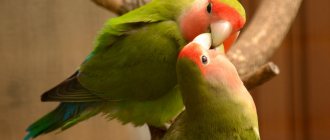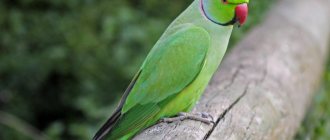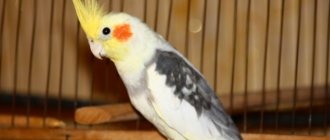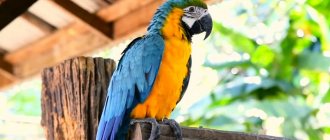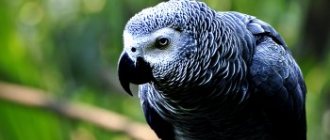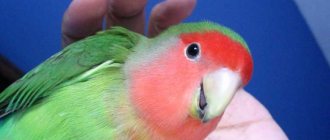The decorative lovebird is a pretty and charming creature. It is ideal for keeping in an apartment due to its sociability and unpretentiousness. Owners are interested in how long their feathered charge will be around. There is no definite answer; each bird has its own life span. Let's talk about how many years a lovebird parrot lives in the wild and at home, what longevity depends on, and how to protect your pet from early death.
Conditions
When choosing a bird to keep at home, you need to know that small breed parrots live much shorter than their larger counterparts. Lovebirds have become a common breed for home keeping.
Often the owner of a parrot is concerned about how long lovebirds live at home. The lifespan of this small bright bird largely depends on the conditions of its keeping:
- Proper balanced food.
- Spacious cage adapted to all the needs of the bird.
- Compliance with temperature and lighting conditions.
An important factor influencing the life expectancy of birds is company for the bird. A lovebird requires a pair for proper development and a long active life.
How many years do lovebirds live in the wild?
In the natural environment, the life of parrots is exposed to many risks. They are attacked by predators and hunted by poachers. Active and curious birds quite often experience stress, get sick, and participate in serious fights with their relatives for possession of a certain territory.
Lovebirds live in the tropical forests of Africa and Madagascar. For local farmers, infestations of hungry parrots often threaten serious losses of ripening crops. Despite the extermination of lovebirds by winged and terrestrial predators, poachers and farmers, the number of birds is not decreasing.
Lovebirds live in the wild for approximately 10–12 years, although the biological capabilities of their body are designed for functional activity lasting approximately 30–35 years. However, individuals of this age are practically not found in nature. Experts believe that the number of years parrots live is greatly influenced by changes in climatic conditions, which force lovebirds to make long and difficult flights.
Factors that encourage sedentary birds to change their habitat are often:
- drought;
- temperature changes;
- reducing the amount of feed;
- increase in the number of predators.
Important! It has been proven that large parrots are able to live longer than birds of medium or small size.
Legend of the Birds
These birds were brought from Madagascar. The colorful, beautiful plumage did not leave people indifferent. Bright parrots are a favorite species among breeders of ornamental poultry.
There is a belief that if one of the lovebirds dies, then the other one will not be able to live without a partner. This attracted attention to this species. In practice, it turned out that proper care and attention can save the surviving bird. After a while, you can add another individual to the cage and not have to wonder how many years lovebirds live in captivity.
How to determine age when purchasing
Lovebirds grow quite quickly; about a month after birth, the dimensions of a young bird are almost in no way inferior to an adult. That is why it is quite difficult to determine the age of a parrot; in this case, you should pay attention to individual morphological signs of youth.
Check out the Australian King Parrot.
To do this, first of all, you should look at:
- cere (formation above the beak) - in birds up to 3 months of age, this zone has a dark and rich shade, and then gradually becomes lighter;
- pupil of the eye - it increases with age, therefore, the younger the bird, the larger the pupil will be;
- beak - in young birds it is small and thin, in turn, in adults it is powerful and thick, with all kinds of damage, chips, etc.
When choosing a parrot, special attention should be paid to the color of the plumage; in most cases, it allows you to instantly distinguish a young individual from an old one. Young lovebirds are distinguished by their rich green color with a grayish tint. In black-winged subspecies, a red spot on the head appears only after the onset of puberty; in masked subspecies, on the contrary, a small spot remains on the head in the beak area until 1 month after birth. Other subspecies retain characteristic spots on the head up to 2 months after birth.
Did you know? Birds appeared on Earth approximately 90 million years ago, and the first species had sharp teeth, like other predators of that time. The beak of birds appeared somewhat later, about 60 million years ago.
Content
The lovebird is an unpretentious bird. Her lifespan is determined by a few simple rules. How long a lovebird lives depends on their observance:
- It is necessary to choose a place for the cage. She shouldn't be near the window. Drafts should not be allowed - all birds are afraid of them. It is also prohibited to place the cage near heating appliances.
- The bird house is placed in a well-lit place, but the bird should not be exposed to direct sunlight. In winter, the lack of sunlight is compensated by artificial lighting.
- It is good to place the cage in a place so that the bird has a large view. Lovebirds love company, so they should always be in the center of events. A blind closed corner is not suitable for placing a bird house. You need to choose a place at the level of the owner’s face - this will make it easier to communicate with the pet.
Communication has a beneficial effect on lovebirds at home: the microclimate in the family determines how many years it will live.
Factors influencing life expectancy
Proper care, a comfortable home, good nutrition, and a daily routine are the basic rules for keeping a tame parrot. If you want to understand from your own experience how long domestic lovers live, create the best living conditions for them.
Spacious cage
A little love bird doesn't take up much space, but that doesn't mean you can buy the smallest cage. Every bird should be able to move comfortably: jump, flap, shake its wings, climb. No matter how many parrots live in the cage, it should be spacious and well equipped. A casing of 60/30/40 cm is enough for one bird, and 80/50/60 cm for a pair.
The cage has the necessary equipment for feeding, as well as devices for an active lifestyle:
The cage should be equipped sparingly and clutter should be avoided.
Carefully! A cluttered cage is more susceptible to injury such as suffocation, jamming, fractures and drowning. In addition, restriction of movement causes depression, and it is unknown how long a depressed bird will live.
Proper nutrition
How much food does a parrot need per day? These birds have a fast metabolism, so they eat often and in small portions. Deviations in nutrition lead to obesity and organ diseases. Sick birds do not live long. It is necessary to feed cabbage rolls with a high-quality cereal mixture, without signs of spoilage. Life expectancy directly depends on proper nutrition.
The staple food consists of seeds and grains, approximately 60% of the daily value. One third consists of succulents such as fruits, vegetables and herbs. The remaining 10% of the parrot's diet consists of mineral feed and fresh twigs - large particles facilitate digestion.
The drinking bowl must have clean water, which is replaced as it gets dirty. If there is food or feces in the water, do not drink it. It is best to install an automatic waterer in a cage, away from perches and feeders. Containers for food and water should be washed daily, dried thoroughly and disinfected from time to time.
Microclimate
Suitable microclimate parameters for small birds: temperature 20-23 degrees and humidity 50-60%. Housewives do not tolerate drafts well and catch colds very easily. They need at least 12 hours of daylight in winter and 15 hours in summer. Sunbathing every day is good for your health. In the sun, birds produce vitamin D, without which calcium cannot be absorbed. In turn, calcium is necessary for the growth of feathers, strong bones, beaks and claws.
Carefully. In case of deterioration in health and well-being, the bird plucks its feathers, which sometimes leads to its death.
Choosing a house
For the correct development of the parrot and its active life, it is necessary to choose a spacious cage. The best option would be a regular square or rectangular-shaped dwelling in which the bird can make several flaps of its wings. The retractable bottom makes cleaning the cage easier.
In addition to the feeder and drinking bowl, the house must have a bath: lovebirds love to splash around. In hot weather, you can freshen the bird with a spray bottle. It is also necessary to equip the cage with crossbars, hanging swings, and toys. All equipment must be periodically disinfected. Maintaining good hygiene for a lovebird determines how many years it will live.
Poor water quality
The bird must have constant access to fresh water, which is renewed daily. Do not fill the drinking bowl from the tap. Water should be chosen without chemical impurities, as they can cause poisoning or illness. The drinking bowl should be washed every day. In the summer, it is advisable to repeat this procedure twice a day. Mineral water is prohibited for parrots, as it contains a large amount of salts.
Nutrition in captivity
This type of bird is suitable for breeding for beginners because it does not require special care. Eats any homemade or factory-made food.
Important! Store-bought grain mixtures for small breeds of parrots should absolutely not be offered to lovebirds.
Special food is produced for medium breed parrots. It must be sifted before use. However, ready-made grain mixtures do not provide all the necessary substances; additional feeding is needed in the form of vegetables, fruits and sprouted greens. Greens in the form of dandelions or spinach are regularly given. The regularity of vitamin intake by lovebirds determines how long they will live.
The daily food intake is 3 tablespoons. Overeating of the bird should not be allowed. This amount should include a teaspoon of low-fat cottage cheese or boiled chicken egg. These products are mixed with wet mixtures.
Alone or in pairs
It is rare for lovebirds to live for a long time at home without a mate; how long is determined by the conditions of detention. Young individuals make contact well. It is difficult to tame an adult bird, especially if it is a solitary parrot. It’s good to feed the chick yourself, then it will be happy to communicate with its owner. Constant interaction is the key to a pet’s long life.
To tame a bird, it is better to buy a pair. This way the bird will settle in better and won’t get bored in its new place. The couple will please the owner for a long time. In this case, you don’t have to wonder how long lovebirds live at home.
These birds are freedom-loving birds. It is advisable to open the cage more often; parrots practically do not live in it. In their house they only eat and while away the nights. The rest of the time, the birds move around the room, exploring the space. If there is no desire to release parrots, a large aviary is needed.
In a room with birds there should be no bright wallpaper or colorful designs. This has a negative impact on the mental health of the birds. It is better, if possible, to decorate the room in pastel, soothing colors.
Important! Smoking is strictly prohibited in a room with birds. Tobacco smoke is toxic to her. The presence of toxic substances in the lovebird's habitat has a detrimental effect on how long it lives.
It is good to provide regular water treatments. This greatly tones up the parrots and allows them to look cheerful and neat.
Causes of early death
No matter how sad it may sound, the owners are often to blame for the fact that a poultry dies before reaching old age. The most common life-threatening factors for lovebirds:
- Open window. A bird that flies out of an apartment will most likely die, since it is not adapted to independent existence.
- Poisonous plants and items made from heavy metals. Curious tomboys are not averse to gnawing on something interesting, which results in poisoning and death.
- Unsuitable food. There are foods that are strictly prohibited for these birds (exotic fruits, almonds, potatoes, pickles); with systematic poor nutrition, there is no guarantee how long your lovebird will live - one year or one month.
- Diseases. Yes, birds get sick, like all living creatures. Only rarely does a person think about the fact that the bird also needs to be shown to a veterinarian, especially if the pet has unusual behavior.
- Weak heart. A parrot often experiences such fear when a cat attacks or unexpected loud sounds that its heart stops, unable to withstand the stress.
- Lack of supervision while walking around the apartment. A lovebird runs the risk of dying if it falls into a container of water, bites through an electrical wire, or hits an obstacle.
- Often small birds die due to the fault of children who cannot calculate their strength and accidentally strangle their pet.

